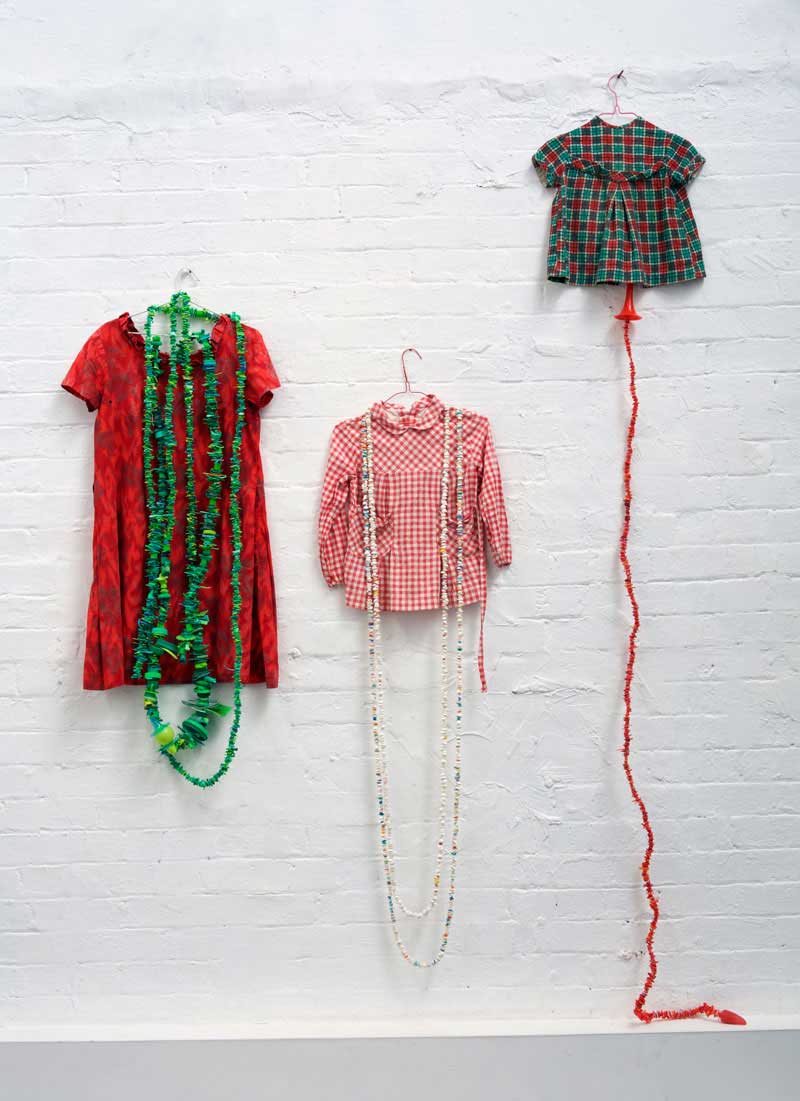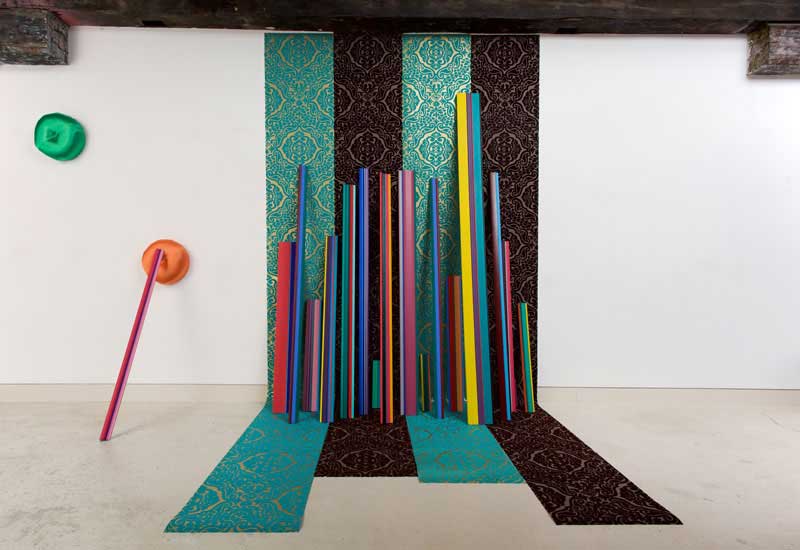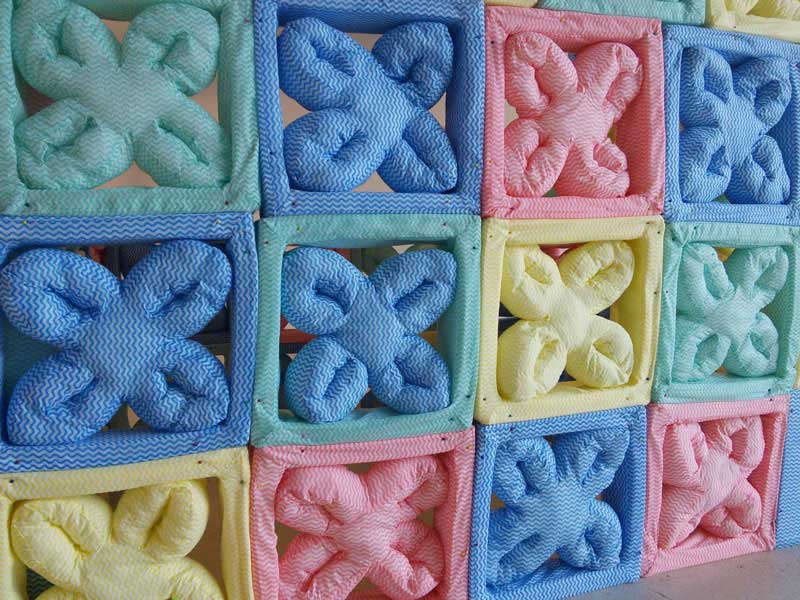
Red/green/black/white dress with red drop, 2018, clothing circa 1960s, found plastic, wire. Image: courtesy the artist. Photo: Ian Hobbs Media
Articulate project space is a rare gem in the Sydney cultural landscape – long may it prosper. Two recent exhibitions, Then and Now by Michele Beevors and Nuha Saad and Making : Memory by Rox De Luca, Michele Elliot and Laurie Paine were intelligent and refreshing complements to early 21st-century discourses of feminist practice.
A mini survey of the last twenty years of practice, the unifying force of architecture was surprising element in the work of Michele Beevors and Nuha Saad. It was exciting to see again South Sydney Juniors (1994) and its companion South Sydney (1994) Saad’s hallucinogenic re-presentations of carpet or wallpaper swatches from a community centre and a suburban home. Colour and pattern are cross-cultural links making the world less foreign, less other. It seems that everywhere can be Lebanese.

Saad employs the inescapable materiality of scale and proportion, the richly potent disjunction of hand-coloured architectural trim and flocked wallpaper in I Walk the Line III (1998–2018) as a riposte to Richard Serra’s Prop series (began 1969) and the masculinist bombast inherent in much of his work. The Colour of Dreams (2018) elegantly encapsulates how in the everyday we negotiate past and present, the handmade and machine-made, the demands of industrial-based standardised modes of living, and the continuing appeal of modernist ideals as represented by the miniature architectonic fantasy of pure colour and form.

Domestic architecture, form and function, childhood memories and the banalities of housework are some of the references at play in Dustcatchers (2018) Michele Beevors. This is a pastel fortress of Wettex and foam. The shape of the individual units is a direct quote of the once-ubiquitous decorative concrete breeze blocks. Here Beevors reverses the familiar, they are now coloured, soft, easily portable, not hard. These relatively cheap industrial units were a suburban leitmotif: a handy windbreak, they hid the downstairs laundry and the garage or were the standout feature of the smartest coastal holiday home circa 1972. In other works, Beevors displays a dark Post-Pop sensibility as evident in the five-part installation Stuffed (2018). Here Black Beauty (2018), a sexy but slightly menacing brocade blow-up horse saddle is juxtaposed against a sly homage to Hollywood and the televisual in TV Static and M and M (2018). Two child-scale skeletons with school satchels all covered/ protected/encased by fine knits had echoes of the Extra B genre of schlock horror apocalypse.
.jpg)
Making : Memory upstairs explored the thematic of the domestic environment as both a generative powerhouse and a holding place of learning, experience and memory. Here fabric is the talismanic metaphor and real-time vehicle for deciphering and translating the past. I remember my mother’s linen cupboard, the rarely used starched and embroidered doilies, the table clothes, “special” towels, sheets and assorted Manchester. It had a unique soapy attar of roses that was so different to every other part of my childhood home. I still proudly wear some of father’s sports and formal shirts. The smells of the “good” linen cupboard are long gone but these fragile fabric items are some of the few tangible links I have with my growing up in country New South Wales.
Laurie Paine’s Social Security Suite (2017) is a hair shirt, crown of thorns and whip made of paper from letters of demand from the Department of Social Security, twigs twine and nails. This work underlines the fact that not all that happens in the domestic environment is defined by a pretty roseate glow. Pain and suffering from economic stress and domestic violence is often exacerbated by government agencies and well-meaning people in authority. In contrast, Untitled (2018) are three extraordinarily fine black silk with gold thread weavings. Part homage to her mother’s Palestinian heritage these pieces feature motifs of tears and starbursts. In other pieces rose petals, old tram tickets and waxed paper straws are captured under threads to similar poetic effect.
.jpg)
Michele Elliot uses gifted clothes items that are reworked, again meticulously over-stitched with needle and thread to create a distilled idea or relic of the person who once wore them. This act of interpretation of the life stories or specific incidents the clothes were once witness to – or rather, part of – gives the lovers (2017–18) a strange tension. On closer inspection some of the threads were like geographical contours one would see on traditional maps, in others the thread work seemed more haptic. The work consists of seven pieces, odd coagulated biomorphic traces, they reminded me of tattooed skin remnants I saw in the Pitt Rivers Museum or microscopic intestinal fauna writ large. Beautifully abject, they speak of the ultimate fiction of memory and interpretation of the past.
.jpg)
Rox De Luca presents precious items such as a tiny silk day dress made and embroidered by her mother, her father’s stolid Melbourne Tramways winter coat, summer shifts and pretty synthetic girls’ togs. These still-loved forms are juxtaposed with strands of plastic detritus collected from Sydney Beaches. I am sure the artist would like us to reflect on the imminent End of Nature with this motif, but instead they provide a sense of joyous enlivenment as the threads twist and turn from the mysterious interior of the pieces or hover like energy fields in front of the familiar items of clothing. The comparatively garish plastic threads can also operate as a sort of quipu, markers of private languages and symbols that all families develop. They also remind me of exploding DNA spirals, demanding the viewer acknowledge linkages through times, blood, emotions and details of events which we can only guess at.
What I enjoyed most about these two distinct exhibitions is how the artists use humble materials and methods of production to frame weighty cultural debates. Indeed, there were many connections across the works on display re-presenting aspects of the post-colonial, the somatic, the domestic, the decorative and the suburban environment.
